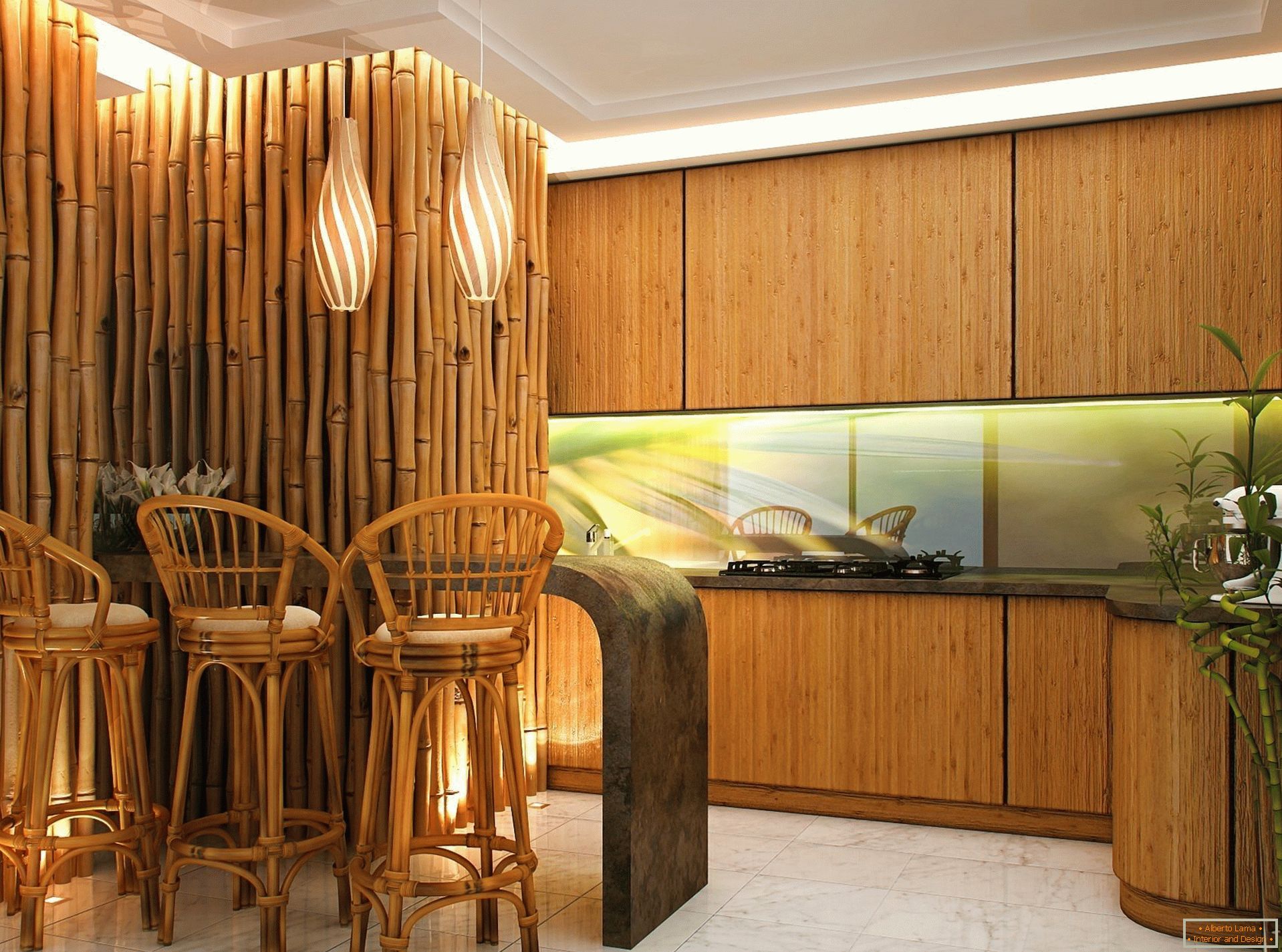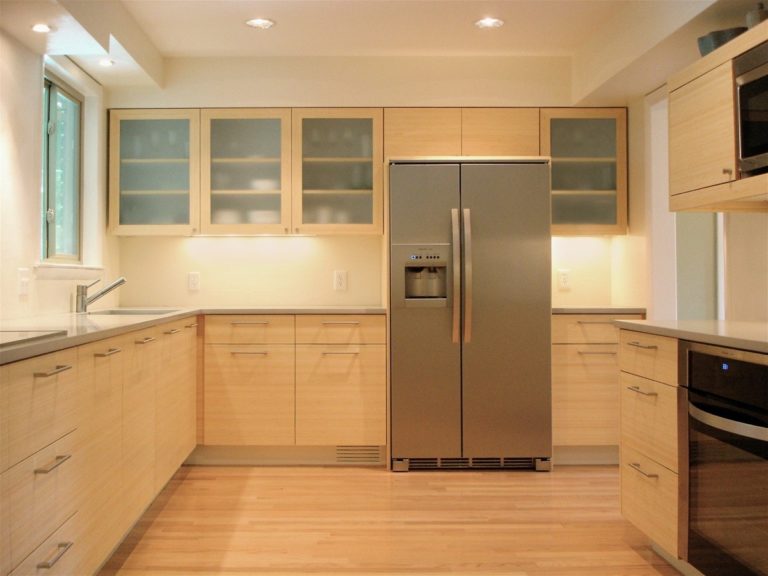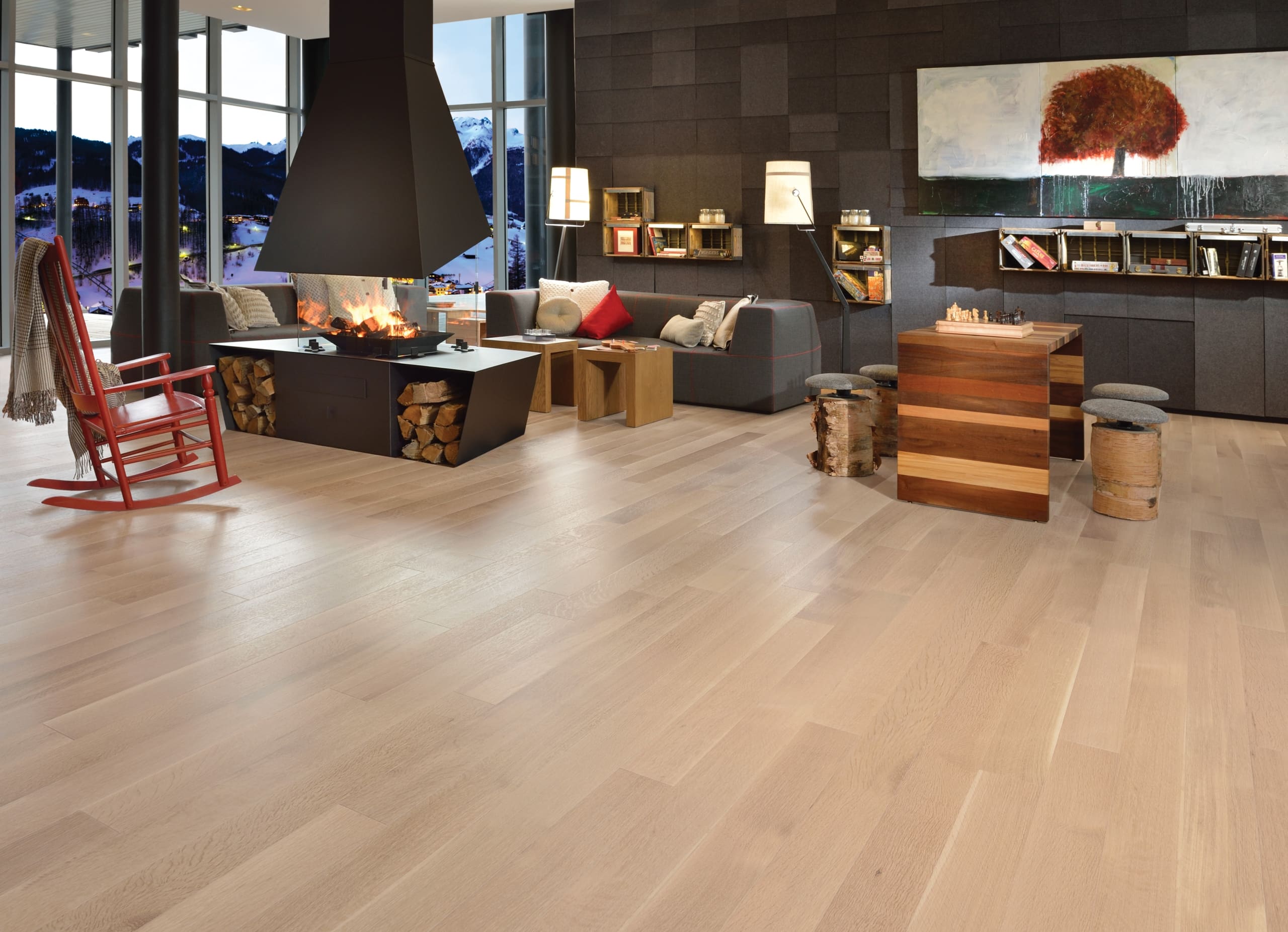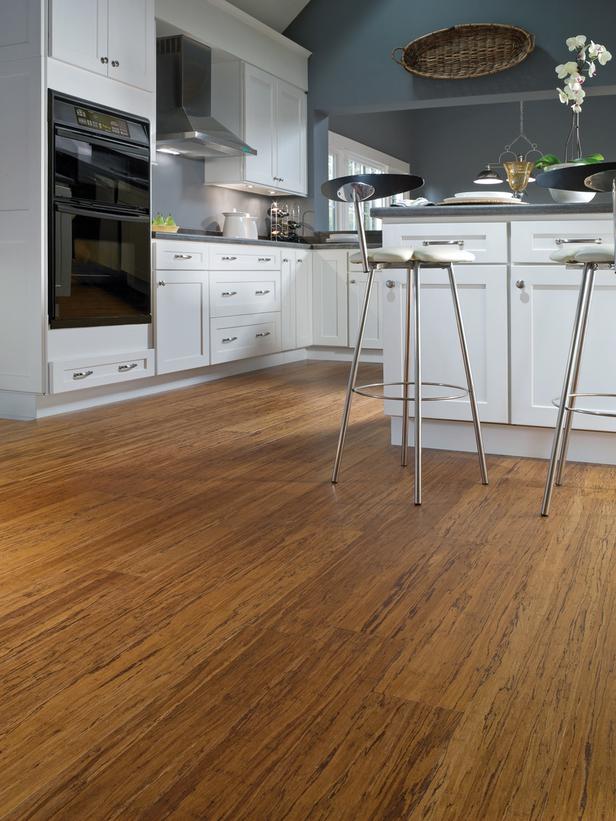Light bamboo flooring has become a popular choice for kitchens due to its durability, eco-friendliness, and modern aesthetic. However, before jumping on the bandwagon, it's important to weigh the pros and cons of this flooring option for your kitchen. Pros: Light bamboo flooring is known for its strength and durability, making it a long-lasting choice for high-traffic areas like the kitchen. It's also resistant to scratches, stains, and moisture, making it a practical choice for a busy kitchen. Additionally, bamboo is a sustainable and renewable material, making it an eco-friendly option for your home. Cons: On the other hand, light bamboo flooring can be more susceptible to discoloration from direct sunlight and can scratch easily if not properly maintained. It's also important to note that not all bamboo flooring brands are created equal, so be sure to do your research and choose a reputable brand for the best quality and longevity.Light Bamboo Flooring in Kitchen: Pros and Cons
Proper maintenance is key to keeping your light bamboo floors looking pristine in the kitchen. Regularly sweeping or vacuuming with a soft brush attachment is recommended to remove any dirt or debris that can scratch the surface. For deeper cleaning, use a damp mop with a mild, non-abrasive cleaner specifically designed for bamboo floors. Avoid using harsh chemicals or excessive water, as these can damage the flooring. For longer-term maintenance, it's important to protect your bamboo floors from direct sunlight by using curtains or blinds. Additionally, consider placing area rugs or mats in high-traffic areas to prevent wear and tear. If your floors do get scratched or discolored, you can lightly sand and refinish them to restore their original beauty.How to Clean and Maintain Light Bamboo Floors in the Kitchen
Light bamboo flooring can add a modern and clean look to any kitchen design. Here are a few ideas to incorporate this flooring option into your kitchen: 1. Contrast with dark cabinets: Pairing light bamboo flooring with dark cabinets creates a striking contrast and adds depth to your kitchen design. 2. Go all-natural: For a more organic and cohesive look, pair light bamboo flooring with natural wood elements in the kitchen, such as wooden countertops or open shelving. 3. Add pops of color: Light bamboo flooring can serve as a neutral backdrop for pops of color in your kitchen, whether it's through colorful backsplash tiles or bold kitchen accessories. 4. Create a minimalist look: The clean, light color of bamboo flooring can contribute to a minimalist and modern kitchen design, especially when paired with sleek, white cabinets.Design Ideas for a Kitchen with Light Bamboo Flooring
When it comes to bamboo flooring, you have the option of going with either a light or dark shade. So which one is better for a kitchen? It ultimately comes down to personal preference and the overall look you're trying to achieve. However, here are a few things to consider: 1. Light bamboo flooring: As mentioned earlier, light bamboo flooring can brighten up a space and create a more airy and modern feel. It can also help conceal scratches and dents better than darker flooring options. 2. Dark bamboo flooring: Dark bamboo flooring can add warmth and richness to a kitchen design. It can also hide dirt and stains better than lighter flooring options. However, it may show scratches and dents more easily.Light Bamboo Flooring vs. Dark Bamboo Flooring: Which is Better for a Kitchen?
When shopping for light bamboo flooring for your kitchen, it's important to choose a reputable brand known for their quality and durability. Some top brands to consider include: 1. Cali Bamboo: This brand offers a wide range of bamboo flooring options, including light shades, that are backed by a 50-year warranty. 2. Ambient Bamboo Floors: Known for their sustainable and eco-friendly practices, this brand offers a variety of light bamboo flooring options in different finishes. 3. Teragren: This brand specializes in bamboo flooring and offers a variety of light shades, as well as unique patterns and textures for a truly one-of-a-kind look in your kitchen.Top Brands for Light Bamboo Flooring in the Kitchen
Installing bamboo flooring in your kitchen can be a DIY project, but it's important to have the right tools and knowledge before getting started. Here's a general guide for installing light bamboo flooring in your kitchen: 1. Prepare the subfloor: Make sure the subfloor is clean, dry, and level before beginning installation. 2. Acclimate the flooring: Let the bamboo flooring acclimate to the room's temperature and humidity for at least 72 hours before installation. 3. Lay down underlayment: Install a moisture barrier and underlayment to protect the bamboo flooring from any potential moisture from the subfloor. 4. Begin installation: Start at one corner of the room and work your way across, using a nail gun or adhesive to secure the planks to the subfloor. 5. Finish with trim: Once all planks are installed, add trim around the edges of the room for a clean and polished look.DIY Installation Guide for Light Bamboo Flooring in the Kitchen
Light bamboo flooring can add a modern touch to any kitchen design. Here are a few tips for incorporating it into a modern kitchen: 1. Keep it minimal: Avoid clutter and stick to clean lines and a simple color palette to maintain a modern and sleek look. 2. Add texture: Consider pairing light bamboo flooring with other textural elements, such as a marble backsplash or wooden countertops, to add interest and depth to the space. 3. Choose complementary colors: Opt for colors that complement the light bamboo flooring, such as shades of gray, white, or black, for a cohesive and modern look.How to Incorporate Light Bamboo Flooring into a Modern Kitchen Design
One of the biggest advantages of choosing light bamboo flooring for your kitchen is its sustainability. Bamboo is a fast-growing grass that can be harvested without killing the plant, making it a renewable and eco-friendly material. It also requires less energy and resources to produce compared to other flooring options, making it a more sustainable choice for your home.Light Bamboo Flooring in the Kitchen: A Sustainable and Eco-Friendly Choice
While light bamboo flooring is durable and easy to maintain, busy kitchens can put it to the test. Here are a few tips to keep your floors looking their best: 1. Wipe up spills immediately: Accidents happen in the kitchen, so it's important to clean up any spills on your bamboo floors as soon as possible to prevent staining. 2. Use rugs and mats: Place rugs or mats in high-traffic areas or under kitchen appliances to prevent scratches and wear on your floors. 3. Avoid high heels: High heels can easily dent and scratch bamboo floors, so it's best to avoid wearing them in the kitchen.Light Bamboo Flooring Maintenance Tips for Busy Kitchens
The cost of light bamboo flooring can vary depending on the brand, quality, and installation method. On average, it can range from $3 to $8 per square foot. Keep in mind that additional costs may include underlayment, installation fees, and any necessary tools. It's important to factor in these costs and your budget when considering light bamboo flooring for your kitchen.Light Bamboo Flooring in the Kitchen: Cost and Budget Considerations
The Benefits of Installing a Light Bamboo Floor in Your Kitchen
:max_bytes(150000):strip_icc()/bamboo-kitchen-172923673-resized-56a2fd8b5f9b58b7d0d00105.jpg)
Enhance the Aesthetic Appeal of Your Kitchen
 Choosing the right flooring for your kitchen is crucial as it can significantly impact the overall look and feel of the space. A light bamboo floor is an excellent choice for kitchens as it adds a touch of warmth and natural beauty to the room. The light color of the bamboo complements any kitchen design, from modern to traditional. Its clean and sleek appearance can make your kitchen look more spacious and bright.
Choosing the right flooring for your kitchen is crucial as it can significantly impact the overall look and feel of the space. A light bamboo floor is an excellent choice for kitchens as it adds a touch of warmth and natural beauty to the room. The light color of the bamboo complements any kitchen design, from modern to traditional. Its clean and sleek appearance can make your kitchen look more spacious and bright.
Durability and Longevity
 Bamboo flooring is known for its durability and strength. It is a highly sustainable material that can withstand heavy foot traffic, making it perfect for high-traffic areas like the kitchen. Its natural resistance to moisture and stains also makes it an ideal choice for kitchens, where spills and messes are common. With proper care and maintenance, a light bamboo floor can last for decades, making it a long-term investment for your home.
Bamboo flooring is known for its durability and strength. It is a highly sustainable material that can withstand heavy foot traffic, making it perfect for high-traffic areas like the kitchen. Its natural resistance to moisture and stains also makes it an ideal choice for kitchens, where spills and messes are common. With proper care and maintenance, a light bamboo floor can last for decades, making it a long-term investment for your home.
Eco-Friendly Option
 If you are looking to make your home more environmentally friendly, installing a light bamboo floor in your kitchen is a great way to start. Bamboo is a highly renewable resource, with some species growing up to 91 cm in a single day. It also does not require the use of harmful chemicals during the manufacturing process, making it a healthier choice for your home and the environment.
If you are looking to make your home more environmentally friendly, installing a light bamboo floor in your kitchen is a great way to start. Bamboo is a highly renewable resource, with some species growing up to 91 cm in a single day. It also does not require the use of harmful chemicals during the manufacturing process, making it a healthier choice for your home and the environment.
Easy to Maintain
 Keeping your kitchen clean and well-maintained is essential for a healthy and hygienic environment. With a light bamboo floor, you can easily achieve this as it is effortless to maintain. Regular sweeping and occasional mopping with a mild cleaner are all that is needed to keep your floor looking pristine. Unlike other types of flooring, bamboo does not easily scratch or dent, making it a low-maintenance option for busy kitchens.
In conclusion, a light bamboo floor is a fantastic choice for your kitchen as it not only enhances the aesthetic appeal of the space but also offers durability, sustainability, and easy maintenance. Consider installing this eco-friendly and stylish flooring option in your kitchen and enjoy its many benefits for years to come.
Keeping your kitchen clean and well-maintained is essential for a healthy and hygienic environment. With a light bamboo floor, you can easily achieve this as it is effortless to maintain. Regular sweeping and occasional mopping with a mild cleaner are all that is needed to keep your floor looking pristine. Unlike other types of flooring, bamboo does not easily scratch or dent, making it a low-maintenance option for busy kitchens.
In conclusion, a light bamboo floor is a fantastic choice for your kitchen as it not only enhances the aesthetic appeal of the space but also offers durability, sustainability, and easy maintenance. Consider installing this eco-friendly and stylish flooring option in your kitchen and enjoy its many benefits for years to come.








:max_bytes(150000):strip_icc()/benefits-and-drawbacks-of-bamboo-floors-1314694_hero_0070-8eaac0f3cc5543c7a73bd85f4106d841.jpg)


































:max_bytes(150000):strip_icc()/bamboo-versus-hardwood-flooring-1314685_hero_0086-f6de61cba7c942b7aa493e85fbf5c401.jpg)








/benefits-and-drawbacks-of-bamboo-floors-1314694-v3-5b102fccff1b780036c0a4fa.png)




























